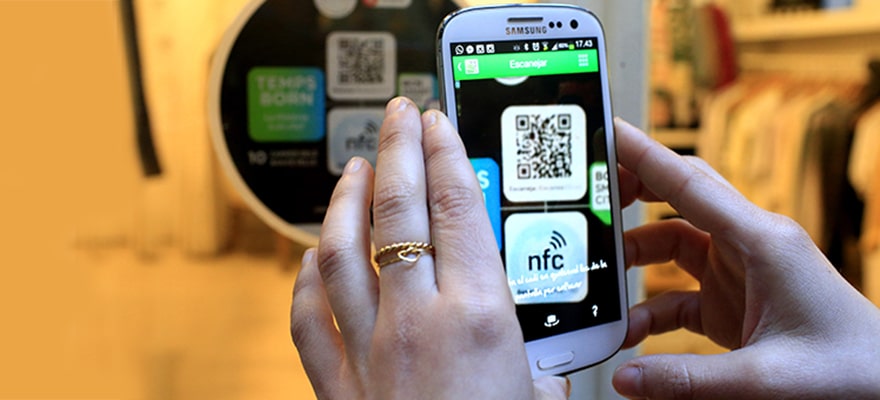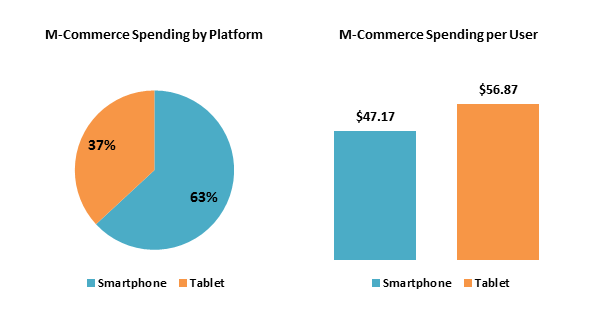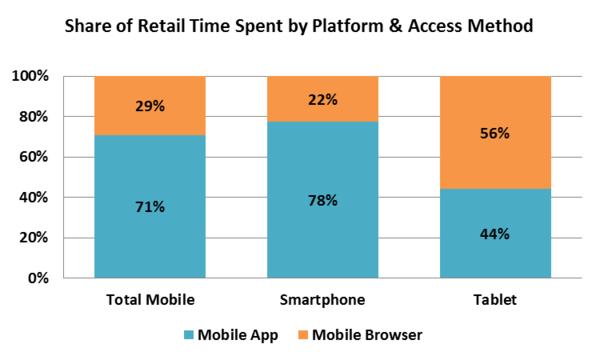Fintech Spotlight: Analyzing M-Commerce Payment Trends
- With data from ECommPay we look into trends of the ‘M-Commerce’ sector and how they are forming the future of the mobile payments space

We all know that the internet is moving to mobile, but what about online orders of good, are they staying on the desktop or is the small screen grabbing consumer wallets as well?
Providing a glimpse of mobile commerce and what are the successful trends of app-based Payments Payments One of the bases of mediums of exchange in the modern world, a payment constitutes the transfer of a legal currency or equivalent from one party in exchange for goods or services to another entity. The payments industry has become a fixture of modern commerce, though the players involved and means of exchange have dramatically shifted over time.In particular, a party making a payment is referred to as a payer, with the payee reflecting the individual or entity receiving the payment. Most commonl One of the bases of mediums of exchange in the modern world, a payment constitutes the transfer of a legal currency or equivalent from one party in exchange for goods or services to another entity. The payments industry has become a fixture of modern commerce, though the players involved and means of exchange have dramatically shifted over time.In particular, a party making a payment is referred to as a payer, with the payee reflecting the individual or entity receiving the payment. Most commonl Read this Term, ECommPay, a provider of payment solutions for online commerce, published their findings on the ‘m-Commerce market’.
Some of the headline figures from their analysis:
- m-Commerce accounts for 1 out of 10 e-Commerce dollars spent
- 1 out of 3 customers access a retail website from a mobile platform
- 35% of major retailer’s audience are ‘mobile only’ consumers
- Apps drive smartphone purchases versus browsers on tablets
- Smartphones are 63% ($6.7B) of total m-Commerce spending but have smaller purchase sizes than tablets
- Average spending by smartphone user is $47 vs $57 for tablet users
App Optimization
Among the data points, the one that is perhaps the most important for mobile payment developers is that smartphone purchases are more likely to take place on apps. According to the data from ECommPay, smartphone apps drove 78% of user traffic versus mobile browsers. However, the opposite was true of tablets with 56% of user engagement still taking place on mobile browsers compared to apps. The data fits well with user trends that have shown that typing and entering user information on smartphones entitles much more friction than larger devices. As such, mobile apps that store user payment details provide a more efficient process to checkout.
For firms in the payment space, the above trends should point towards greater demand from app developers for biometric verification products. Such features would allow mobile users greater feeling of security for information stored on their apps in the case of theft of their devices. In addition to Apple which introduced fingerprint identification to mobile devices, other firms such as American Express as well as startups like Jumio and OneVisage have been creating products that integrate facial recognition into app-based payments.
Retention
Among ECommPay’s takeaways from the analysis was that m-Commerce developers need to focus on retention. Knowing that retail user bases are migrating more towards mobile for not only discovery of products but purchases as well, means not only optimizing the checkout process, but also continued engagement. In this regard they cited that mobile shopping rates spike during the Q4 holiday season, but fall dramatically in the following two quarters. ECommPay suggested that retailers should use the lagging periods to target mobile shoppers to keep them engaged in preparation of Q3 and Q4 when mobile spending rates spike higher.
Fintech Fintech Financial Technology (fintech) is defined as ay technology that is geared towards automating and enhancing the delivery and application of financial services. The origin of the term fintechs can be traced back to the 1990s where it was primarily used as a back-end system technology for renowned financial institutions. However, it has since grown outside the business sector with an increased focus upon consumer services.What Purpose Do Fintechs Serve?The main purpose of fintechs would be to suppl Financial Technology (fintech) is defined as ay technology that is geared towards automating and enhancing the delivery and application of financial services. The origin of the term fintechs can be traced back to the 1990s where it was primarily used as a back-end system technology for renowned financial institutions. However, it has since grown outside the business sector with an increased focus upon consumer services.What Purpose Do Fintechs Serve?The main purpose of fintechs would be to suppl Read this Term Spotlight is a new column on Finance Magnates devoted to reviewing innovative financial technology companies and sector trends.
We all know that the internet is moving to mobile, but what about online orders of good, are they staying on the desktop or is the small screen grabbing consumer wallets as well?
Providing a glimpse of mobile commerce and what are the successful trends of app-based Payments Payments One of the bases of mediums of exchange in the modern world, a payment constitutes the transfer of a legal currency or equivalent from one party in exchange for goods or services to another entity. The payments industry has become a fixture of modern commerce, though the players involved and means of exchange have dramatically shifted over time.In particular, a party making a payment is referred to as a payer, with the payee reflecting the individual or entity receiving the payment. Most commonl One of the bases of mediums of exchange in the modern world, a payment constitutes the transfer of a legal currency or equivalent from one party in exchange for goods or services to another entity. The payments industry has become a fixture of modern commerce, though the players involved and means of exchange have dramatically shifted over time.In particular, a party making a payment is referred to as a payer, with the payee reflecting the individual or entity receiving the payment. Most commonl Read this Term, ECommPay, a provider of payment solutions for online commerce, published their findings on the ‘m-Commerce market’.
Some of the headline figures from their analysis:
- m-Commerce accounts for 1 out of 10 e-Commerce dollars spent
- 1 out of 3 customers access a retail website from a mobile platform
- 35% of major retailer’s audience are ‘mobile only’ consumers
- Apps drive smartphone purchases versus browsers on tablets
- Smartphones are 63% ($6.7B) of total m-Commerce spending but have smaller purchase sizes than tablets
- Average spending by smartphone user is $47 vs $57 for tablet users
App Optimization
Among the data points, the one that is perhaps the most important for mobile payment developers is that smartphone purchases are more likely to take place on apps. According to the data from ECommPay, smartphone apps drove 78% of user traffic versus mobile browsers. However, the opposite was true of tablets with 56% of user engagement still taking place on mobile browsers compared to apps. The data fits well with user trends that have shown that typing and entering user information on smartphones entitles much more friction than larger devices. As such, mobile apps that store user payment details provide a more efficient process to checkout.
For firms in the payment space, the above trends should point towards greater demand from app developers for biometric verification products. Such features would allow mobile users greater feeling of security for information stored on their apps in the case of theft of their devices. In addition to Apple which introduced fingerprint identification to mobile devices, other firms such as American Express as well as startups like Jumio and OneVisage have been creating products that integrate facial recognition into app-based payments.
Retention
Among ECommPay’s takeaways from the analysis was that m-Commerce developers need to focus on retention. Knowing that retail user bases are migrating more towards mobile for not only discovery of products but purchases as well, means not only optimizing the checkout process, but also continued engagement. In this regard they cited that mobile shopping rates spike during the Q4 holiday season, but fall dramatically in the following two quarters. ECommPay suggested that retailers should use the lagging periods to target mobile shoppers to keep them engaged in preparation of Q3 and Q4 when mobile spending rates spike higher.
Fintech Fintech Financial Technology (fintech) is defined as ay technology that is geared towards automating and enhancing the delivery and application of financial services. The origin of the term fintechs can be traced back to the 1990s where it was primarily used as a back-end system technology for renowned financial institutions. However, it has since grown outside the business sector with an increased focus upon consumer services.What Purpose Do Fintechs Serve?The main purpose of fintechs would be to suppl Financial Technology (fintech) is defined as ay technology that is geared towards automating and enhancing the delivery and application of financial services. The origin of the term fintechs can be traced back to the 1990s where it was primarily used as a back-end system technology for renowned financial institutions. However, it has since grown outside the business sector with an increased focus upon consumer services.What Purpose Do Fintechs Serve?The main purpose of fintechs would be to suppl Read this Term Spotlight is a new column on Finance Magnates devoted to reviewing innovative financial technology companies and sector trends.


